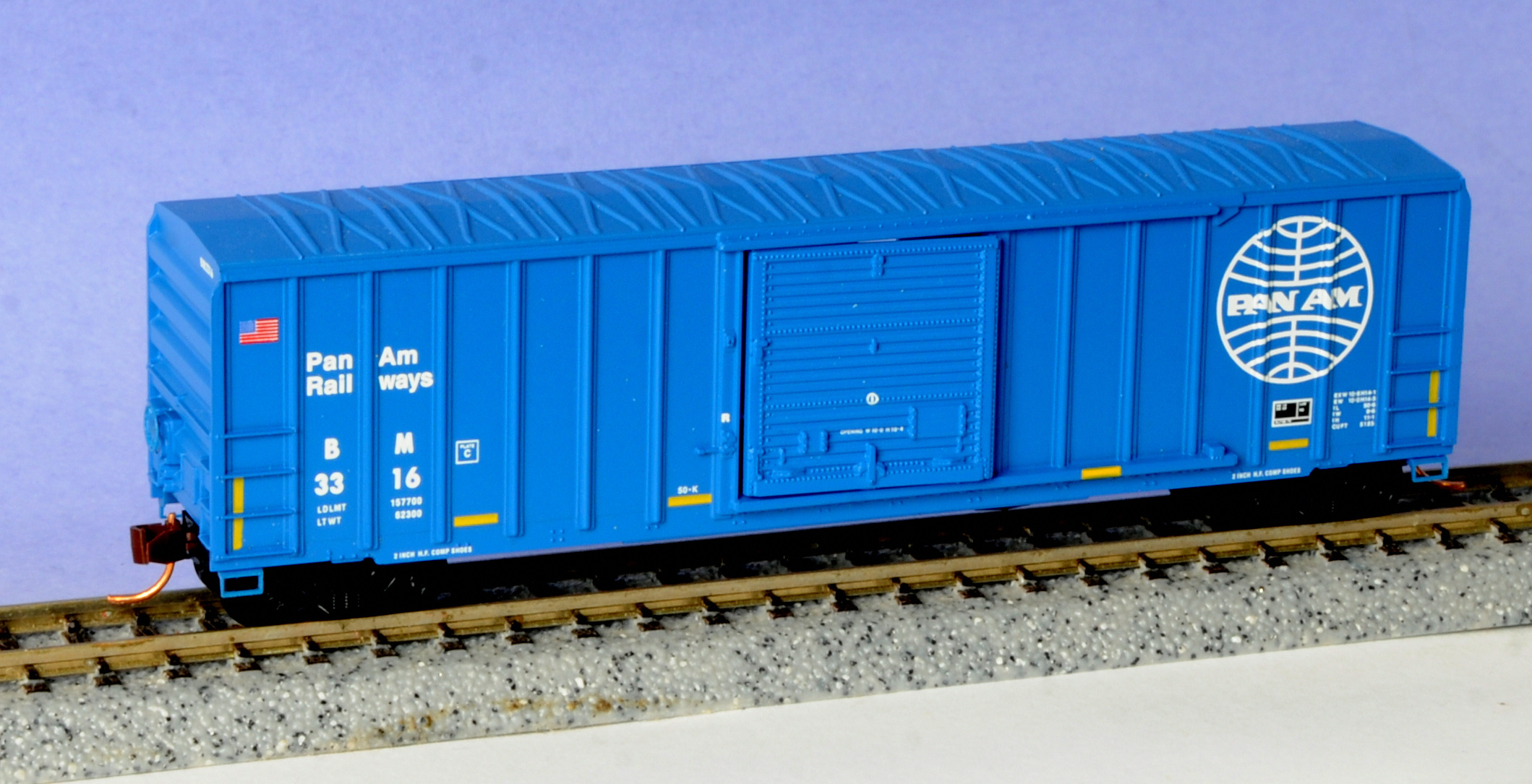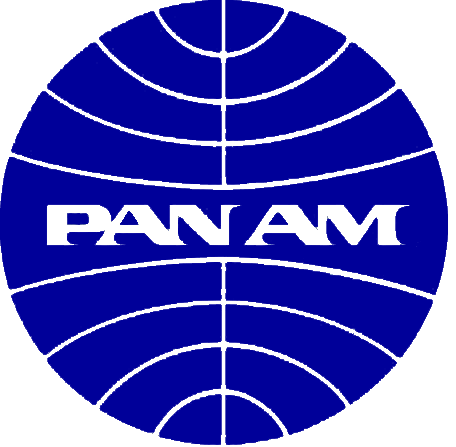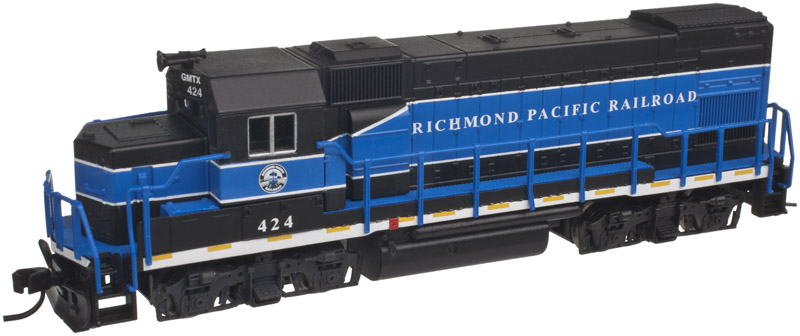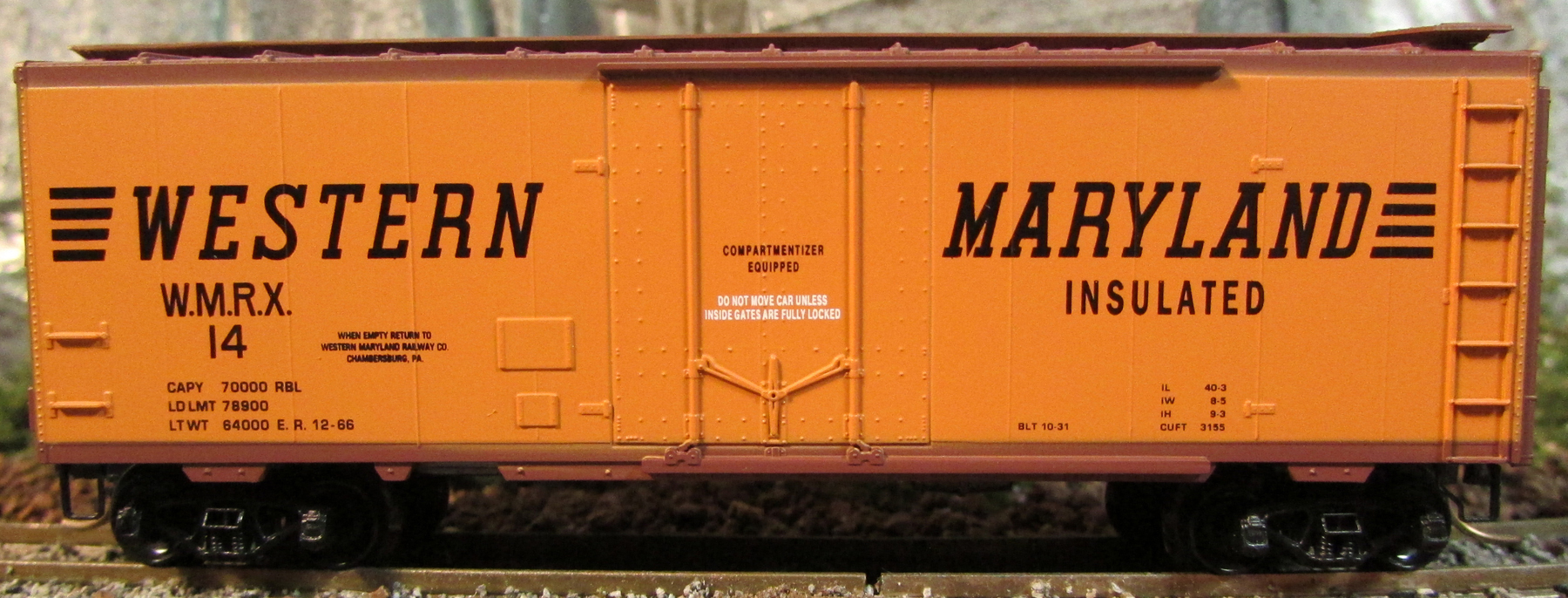Specific Item Information: This 50 foot rib side box car with single door and no roofwalk is painted blue with white lettering and runs on Barber Roller Bearing trucks. Formally known as Guilford Transportation Industries, the Massachusetts based company bought the name and logo of the former Pan American World Airways in 1998. This Class 2 railroad operates through much of New England from Maine to New York.
Model Information: This model was first produced by Kadee in February of 1981. It is a model of a 50 Foot Steel Rib-Side Single Sliding Door Boxcar. Specifically, this Micro-Trains body style models the FMC 50' 5077 Single Sliding Door prototype. It is also used by Micro-Trains to model Pullman Standard 50' boxcars. Hence on some releases, this car is labeled as a Pullman Standard and in other cases it is labeled as an FMC boxcar, and it also is frequently labeled as a '50' Rib Side Box Car[sic]' with no mention of prototype whatsoever. It appears to be closest to the FMC 5077 boxcar prototype (from the 1970s) in any event. These models can appear with any one of multiple different sliding door types. The doors for this model are operating ones (cool!).
Prototype History: In the 1970's with the growth of the Per Diem business model, FMC produced a series of 50 foot box cars in different configurations. The single-sliding-door configuration is one of the best known and used widely by many different railroads. These cars were produced using the Gunderson metal works which FMC had acquired in 1965. In late 1975, FMC began producing a 5,077-cubic-foot Plate B box car for IPD and Railbox service. FMC's 5077s have seven panels to either side of the 10-foot door, an X-panel roof, and non-terminating ends that are slightly different from those used on FMC's earlier cars. Note how the sidesill is notched all the way back to the bolsters, a key feature of FMC's mature design.
The main difference between the 5077 cu. ft cars built by FMC vs the 5277-5347 cu. ft cars built by the same manufacturers is the overall height of the car, the smaller 5077 cars were Plate B while the larger 5277-5347 cars were Plate C. Over 4,300 cars were produced from 1975-1979 by FMC's Portland, Oregon plant. The cars were delivered in numerous colorful shortline paint schemes, as well as the nationwide car pool fleet of Railbox. Many secondhand cars were later seen in Class 1 railroads and large leasing company fleets under additional shortline reporting marks.
The main difference between the 5077 cu. ft cars built by FMC vs the 5277-5347 cu. ft cars built by the same manufacturers is the overall height of the car, the smaller 5077 cars were Plate B while the larger 5277-5347 cars were Plate C. Over 4,300 cars were produced from 1975-1979 by FMC's Portland, Oregon plant. The cars were delivered in numerous colorful shortline paint schemes, as well as the nationwide car pool fleet of Railbox. Many secondhand cars were later seen in Class 1 railroads and large leasing company fleets under additional shortline reporting marks.
Road Name History: The Pan Am Railways mission is to be the leading freight transportation company in our region. We will meet this expectation by combining the economies of rail transportation with the highest levels of safety and service in order to provide value to our customers and the communities through which they pass.
Pan Am Railways, Inc. (PAR), formerly known as Guilford Rail System (GRS) before March 2006, is an American holding company that owns and operates Class II regional railroads covering northern New England from Mattawamkeag, Maine, to Rotterdam Junction, New York. The primary subsidiaries of Pan Am Railways are Boston and Maine Corporation (reporting mark BM), Maine Central Railroad Company (reporting mark MEC), Portland Terminal Company (reporting mark PTM), and Springfield Terminal Railway Company (reporting mark ST); BM and MEC are operated under lease by ST.
Pan Am Railways is headquartered in Iron Horse Park in North Billerica, Massachusetts. It is a subsidiary of Portsmouth, New Hampshire-based Pan Am Systems, formerly known as Guilford Transportation Industries (GTI). Guilford bought the name, colors and logo of Pan American World Airways in 1998.
From Company Website and Wikipedia
Pan Am Railways, Inc. (PAR), formerly known as Guilford Rail System (GRS) before March 2006, is an American holding company that owns and operates Class II regional railroads covering northern New England from Mattawamkeag, Maine, to Rotterdam Junction, New York. The primary subsidiaries of Pan Am Railways are Boston and Maine Corporation (reporting mark BM), Maine Central Railroad Company (reporting mark MEC), Portland Terminal Company (reporting mark PTM), and Springfield Terminal Railway Company (reporting mark ST); BM and MEC are operated under lease by ST.
Pan Am Railways is headquartered in Iron Horse Park in North Billerica, Massachusetts. It is a subsidiary of Portsmouth, New Hampshire-based Pan Am Systems, formerly known as Guilford Transportation Industries (GTI). Guilford bought the name, colors and logo of Pan American World Airways in 1998.
From Company Website and Wikipedia
Brand/Importer Information: Micro-Trains is the brand name used by both Kadee Quality Products and Micro-Trains Line. For a history of the relationship between the brand and the two companies, please consult our Micro-Trains Collector's Guide.
Manufacturer Information:  Micro-Trains Line split off from Kadee Quality Products in 1990. Kadee Quality Products originally got involved in N-Scale by producing a scaled-down version of their successful HO Magne-Matic knuckle coupler system. This coupler was superior to the ubiquitous 'Rapido' style coupler due to two primary factors: superior realistic appearance and the ability to automatically uncouple when stopped over a magnet embedded in a section of track. The success of these couplers in N-Scale quickly translated to the production of trucks, wheels and in 1972 a release of ready-to-run box cars.
Micro-Trains Line split off from Kadee Quality Products in 1990. Kadee Quality Products originally got involved in N-Scale by producing a scaled-down version of their successful HO Magne-Matic knuckle coupler system. This coupler was superior to the ubiquitous 'Rapido' style coupler due to two primary factors: superior realistic appearance and the ability to automatically uncouple when stopped over a magnet embedded in a section of track. The success of these couplers in N-Scale quickly translated to the production of trucks, wheels and in 1972 a release of ready-to-run box cars.
Micro-Trains Line Co. split off from Kadee in 1990 to form a completely independent company. For this reason, products from this company can appear with labels from both enterprises. Due to the nature of production idiosyncrasies and various random factors, the rolling stock from Micro-Trains can have all sorts of interesting variations in both their packaging as well as the products themselves. When acquiring an MTL product it is very important to understand these important production variations that can greatly enhance (or decrease) the value of your purchase.
Please consult our Micro-Trains Collector's Guide

Micro-Trains Line Co. split off from Kadee in 1990 to form a completely independent company. For this reason, products from this company can appear with labels from both enterprises. Due to the nature of production idiosyncrasies and various random factors, the rolling stock from Micro-Trains can have all sorts of interesting variations in both their packaging as well as the products themselves. When acquiring an MTL product it is very important to understand these important production variations that can greatly enhance (or decrease) the value of your purchase.
Please consult our Micro-Trains Collector's Guide
Item created by: gdm on 2016-07-05 13:34:37. Last edited by gdm on 2021-02-12 15:41:36
If you see errors or missing data in this entry, please feel free to log in and edit it. Anyone with a Gmail account can log in instantly.
If you see errors or missing data in this entry, please feel free to log in and edit it. Anyone with a Gmail account can log in instantly.










